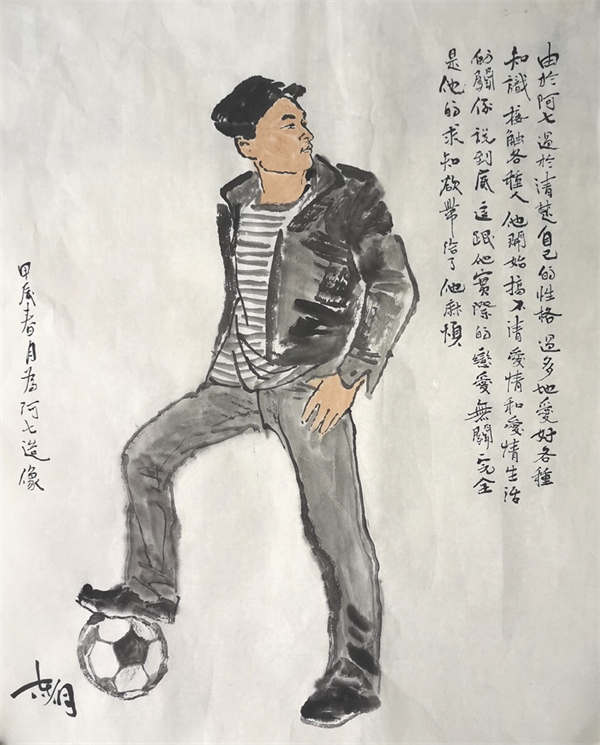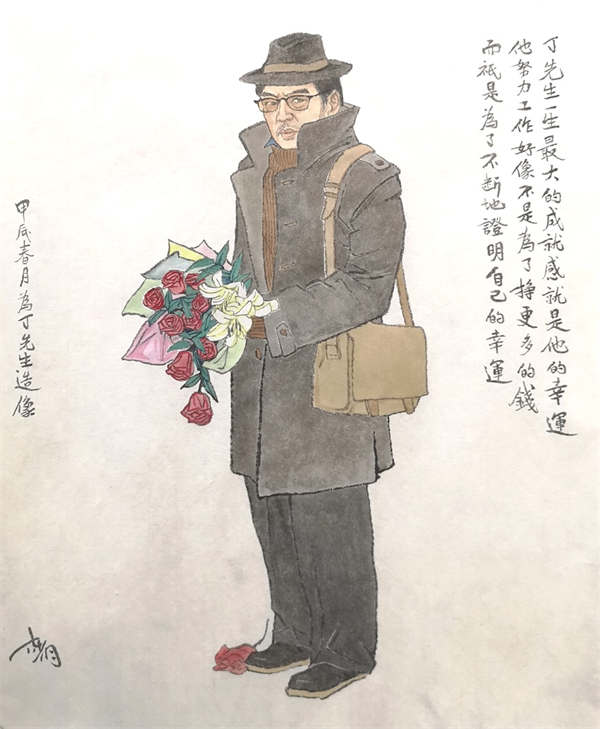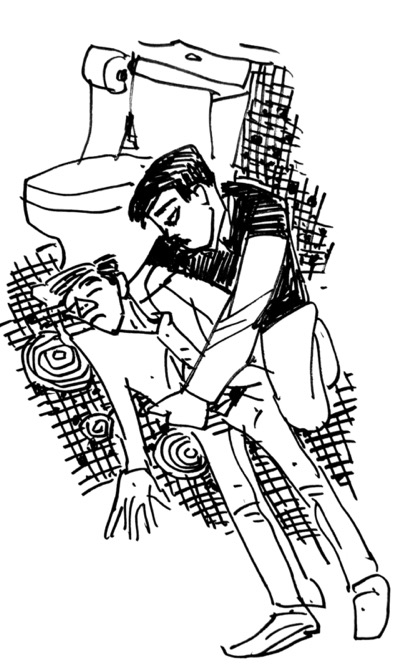The Heartbreaker
/Exhibition of Illustrations/

Exhibition Opening / 2024.04.12 3:30p.m.
Venue / Hu Ancestral Hall, No.8 Buxiangli, Huangpu Ancient Port, Haizhu District, Guangzhou
Artist / Chen Tong
Curators / InterCulture Curatorial Team
Host / InterCulture
Foreword/

After 30 years as a bookstore owner and publisher, Chen Tong’s first novel, The Heartbreaker, was published on March 26th. Chen Tong wants his readers to forget about his identity as a professional painter and focus only on his words. He doesn't want pictures to limit the readers' imagination, so there is not a single illustration in the novel, although he’s an expert on illustration, thanks to his profound background in comic strips.

After the novel was written, the cover still had to be drawn by the author himself, and the characters in the book added up to the dozen or so on the cover, so it was easy to look at the picture and recognize the right person. After finishing the cover, he continued to paint bookmarks, postcards, and gradually found the excitement. Thus, Chen Tong, determined not to add illustrations, changed his mind and couldn't help but give each character a real and vivid face, as if it could come out of the paper.
Artist's Statement/
01

If literature is added to the identity of " cross-media artist ", what I want to write is a pure novel, and what I am going to write next is a pure novel with only words. In terms of the form of the "book", although novels evoke images, the book "The Heartbreaker" will not be illustrated. This desire may not exist for the average writer, or perhaps the opposite, who wants illustrations to appear every few pages. And, from a publisher's point of view, novels with illustrations will sell better, and who says otherwise?
02
I'm originally a painter and specialise in illustrations and comic strips, and I was worried that once I illustrated my novels, readers wouldn't take my words seriously, but would instead feel that the novels were words I'd put to pictures, like the usual inscriptions on those paintings.

I write novels not because I have extra time to fiddle with words, but because I see that words and pictures serve different purposes, including being accepted by different groups of people. For example, how can a picture express the Cantonese language? Unless you draw a circle on the picture and write "This is Cantonese" in it. However, words are different, as they directly refer to the meaning and significance in Cantonese, which is easily understood by people.
We live in a variety of languages, and we need languages for communication and even for labour. The language of painting requires a certain "professional foundation" of knowing how to read paintings, which to a certain extent hinders the expression of meaning, so paintings often don't pay attention to plots, and the only paintings that do pay attention to plots are illustrations and comic strips. As for words used for daily communication, when they are used well, those who receive information from them will have images emerging in their minds, and the images are different for each person, that’s why the author will do his best to be as accurate as possible. Even so, the author will still say that he is sometimes not sure what the pictures and images in the novel are like, and that his focus may be on the sounds, on the semantics and phonetics of the thoughts and emotions.

When my French writer friends learnt that my novel was about to be published, they suggested that it should also be published in French as a "graphic novel", which, if they hadn't thought of it on the basis of my status as a painter, would be because of the popularity of graphic novels in France. This is not surprising, because in the age of pictures, we are surrounded by photographs, and maybe pictures are particularly popular in France.

In fact, the novel The Heartbreaker was originally a narrative created from a video, so it is based on "images". The video was filmed at the end of 2018, titled "Small Street Style", and tells a fictional story that takes place on Changxing Street in the old city of Guangzhou, related to bookstores and love, with a very clichéd plot and very conceptual characters, but as an interlude, The Heartbreaker is very touching, especially the lyrics "Although love can make life more beautiful, it is also like the weather in summer that can change at will", which is not only true for the abandoned pregnant woman in the novel, but also for all those who believe in love. What is sad is not only the loss of love, but also the time that is gone forever.

03
The transformation of an image into a "picture" seems to require only form and technique, whereas the composition of a novel requires more imagination. The video as a melodrama has no written script (the "full script" in the novel as an appendix was added after the fact), and not even much dialogue, but it is rehearsed with clear characters, from their identities to their dress and actions, all of which are predetermined, and at the same time, these predeterminations refer to a certain social context. In other words, even if these characters stand in a row and do nothing, one can still make a good guess about their roles and functions in the story.
As I said in my "preface" to the novel, "A Letter," I am all people and all things. This "I" is of course not the me that the reader sees, but the author's presence. Even if the ubiquitous I speaks the words of the Other, it is based on the fact that I have thought of it and know what reaction it will cause. The "I" is not singular or pure, but multifaceted and composite. Without this "I", the author would be a mere scribe, unaccountable for observation, understanding and expression, and unable to know how much potential he or she possesses.

04
Although a picture may seem more like an imitation of life, it still carries "my" gaze, "my" interests and choices, so it is not a rival to the written word, only a possible accomplice. When I write a novel, I feel that I am actually making a film, that I have a clear picture in my mind, and that I even use camera angles (for example, I always write about the angle from which I am looking at it), montages and repetitions. Therefore, is drawing all about burning down these images with lines? This function is only "aesthetic" in terms of the rhythm of the image, but in other ways it means conveying the meaning of the text without filling in the necessary gaps. In an illustration where there are fewer or more objects than depicted in the novel, the characters will have specific characteristics and at the same time become more recognisable. If these more or lesser things, and these typified images, do not prove to be necessary by the form and technique of the illustration, then they are really superfluous in comparison with the text.
With this kind of notion, I have selected this illustration work that I originally did not want to do, except for the “embroidered images” that feature the "typical action" in the "typical environment" of the characters. In other words, I want them to fit in the plot of the novel, but also to become a picture book for another story, or an illustration for the novel, a kind of document created on the spot in order to draw out more possibilities.


Artist/

Chen Tong, born in 1962 in Ningxiang County, Hunan Province, was admitted to the Department of Chinese Painting at the Guangzhou Academy of Fine Arts in 1979. After graduation, he worked as an editor at the Hunan Youth Publishing House, and has taught at the School of Chinese Painting at the Guangzhou Academy of Fine Arts from 1986 to the present day, where he has successively served as the studio director and the vice-director of the School of Chinese Painting, and retired from teaching in October 2022; he now lives in Shunde, Foshan and Guangzhou.
As a cross-media artist, Chen Tong's artistic practice includes Chinese paintings, comic books, novels, videos, theatre and installations, as well as being a publishing curator and an institutional practitioner of contemporary art, with the joint founding of Libreria Borges in Guangzhou, and the curation and publication of the "Experimental Art Series", "Collection Minuit" and "Sybarite". "In 2010, he was awarded the Chevalier de l'Ordre des Arts et des Lettres (Knight of the Order of Arts and Letters) by the French Ministry of Culture in recognition of his contribution to cultural exchanges between France and China.
